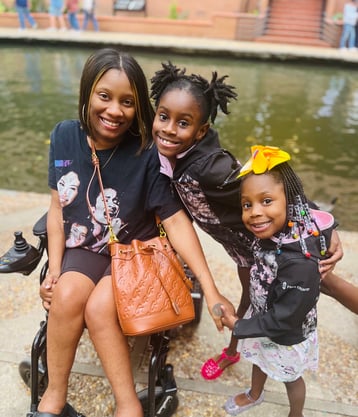Anna Holly always wanted to be a mother. The oldest of five, Holly grew up in a tightly knit Detroit family paying particularly close attention to the love that anchored her grandparents’ marriage. She resolved to one day build a similar life for herself.

The fact that she’d sustained a C-6 incomplete spinal cord injury (SCI) when she was 14 months old may have seemed like a barrier to some — but not to Holly.
“It never crossed my mind that I wouldn't be able to do it,” she says.
When she met Ernest Holly not long after her 21st birthday, the future family she’d dreamed of came into focus.
“On our first date, he said that he was going to marry me,” she says. “And I believed him. I knew this was my person.”
Before then, Holly had never seen an OB-GYN for gynecological care. Like many other women living with paralysis who struggled to find accessible healthcare, Holly made do with visits to a nurse practitioner. But with an eye on her reproductive health, Holly began searching for an OB-GYN.
“That was an experience,” she says. “I had a few doctors tell me that they couldn’t work with me because of the SCI.”
Holly eventually found a doctor who was willing to learn about spinal cord injury, had an adjustable examination table (but not an accessible scale), and — critically — would be supportive of natural childbirth when the time came.
“That was the most important thing,” Holly says. “I wanted to experience the whole thing and I knew I could do it.”
Ernest Holly proposed in April 2014. Two months later, Holly discovered she was pregnant.
“I took one pregnancy test and then went out and got eight more because I couldn't believe it,” she laughs.
Most of their family members and friends were thrilled — “they knew what I was capable of doing” — but a few gently asked questions that revealed their doubts, including whether Holly would hire a nurse to help her care for the baby.
“I ignored the noise because I’ve been doing it my whole life,” she says. “People will say things like, ‘How is she going to do this? How is that going to happen?’ And each time I will prove them wrong.”
Holly began to prepare. She sought out blogs written by parents with disabilities, following the lives of women like her who were already on their way as mothers. She and Ernest painted the nursery pink, convinced they would welcome a baby girl. And, determined to have the natural birth she wanted, Holly began physical therapy to help increase her hip flexibility.
For the most part, her pregnancy was like any other, a mix of routine symptoms – fatigue and morning sickness – tempered with those stemming from her injury. In her first trimester Holly struggled with kidney infections, a common complication for women with paralysis, until her OB-GYN increased her catheter supply to adapt to her changing needs. And, as her body grew, the weight gain gradually shifted her center of gravity, making transfers more difficult.
A lack of accessible equipment in medical offices created a different set of challenges. Her husband was a key partner throughout, providing transfers during ultrasounds and appointments when examination tables were not adjustable and wheelchair scales were scarce.
“They found a technique to weigh me where my husband would get on the scale and they would get his weight,” Holly says. “Then he would pick me up on the scale with him and they would subtract for mine. And they still do it to this day.”
By her third trimester, she was seeing doctors twice a week to monitor her breathing and circulation, touring the hospital, and taking parenting classes. Though some women with paralysis experience pre-term labor, Holly was induced near her due date. Because her injury is incomplete, she felt “everything.”
“Oh, wow, it was really intense,” she says. “But I breathed through it.”
After more than a day of labor, the baby’s heart rate began to drop. Despite Holly’s hopes for a natural delivery, an emergency cesarean section was needed. She was crushed, but the moment she held her daughter Allison for the first time restored her joy.
“It was beautiful,” she says. “This was a baby I had prayed for. And people doubted that I could do it. So, it was special.”

